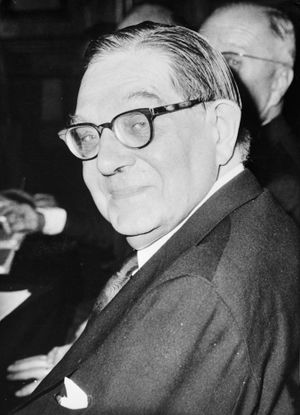Per Jacobsson
(economist) | ||||||||||||||||
|---|---|---|---|---|---|---|---|---|---|---|---|---|---|---|---|---|
 | ||||||||||||||||
| Born | 1894-02-05 Tanum, Bohuslän, Sweden | |||||||||||||||
| Died | 1963-05-05 (Age 69) London, United Kingdom | |||||||||||||||
| Nationality | Sweden | |||||||||||||||
| Alma mater | Uppsala University | |||||||||||||||
Attended 2 Bilderbergs as Managing Director of the IMF
| ||||||||||||||||
Per Jacobsson was a Swedish monetary economist and international public servant, and for more than forty years a leading spokesman for policies of monetary stability and international financial cooperation, working primarily in the field of public finance.
Contents
Early Career
He was a member of the Economic and Financial Section of the League of Nations Secretariat from 1920 to 1928, taking an active part in its financial reconstruction work in Europe and thus starting the career of international public service to which he devoted most of his life. Among his striking predictions that were of special significance for the evolution of public policy was the daring forecast in 1925 that interest rates would soon begin a major decline in the principal countries of the West (1925).
He spent the years 1928–1931 in Sweden, first in public service, and a brief period, 1930–1931, in private business.
Bank for International Settlements
In 1931 Jacobsson became head of the Monetary and Economic Department of the newly-established Bank for International Settlements in Basel, Switzerland, "the central bank's central bank".
He worked there for 25 years. Here he was an unofficial and confidential counselor to many of the world’s leading central bankers and statesmen. His official responsibility centered on the preparation of the bank’s Annual Report. First published in 1931, the report, under his guidance, became known as the most influential diagnosis of the principal events and forces at work in the world’s economy to appear anywhere.
He was a member of the Irish Banking Commission, whose report led to the establishment of the Central Bank of Ireland, and he conducted a number of special inquiries into the economic and financial problems of Austria, France, Germany, Italy, the Netherlands, and the Sterling Area. In 1952 he was instrumental in setting up the Basle Centre for Economic and Financial Research.[1]
After World War II, he was also one of the first to see that massive postwar demand would preclude the postwar depression expected in the United States and elsewhere.[2]
International Monetary Fund
In 1956, Jacobsson was offered the job as leader of the IMF. The offer came as a surprise to many, but in spite of the negative advice of some of his close colleagues and friends, Jacobsson decided to accept it[3].
Jacobsson assumed his duties as Managing Director of the International Monetary Fund in November 1956. Shortly thereafter, a large United Kingdom credit from the Fund was instrumental in restoring financial confidence shaken by the Suez crisis, and in [1961]], the Fund again took a leading part in operations that helped stabilize the position of the pound sterling.
In 1958, Jacobsson was convinced, when many others were doubtful, that France was ready for monetary stability. With daring and initiative he led the Fund to its decision to assist France through rigorous application of the classic IMF approach of monetary stability and budgetary restraint. The resulting stabilization of the franc proved to be the major prerequisite for the widespread restoration of European currency convertibility that occurred at the end of 1958.
Apart from meeting the immediate financial strains which that crisis produced for several countries, Jacobsson concentrated his attention on containing the continuing world-wide forces of inflation.
The IMF started borrowing more to poorer countries, leading to a debt-trap system (see: John Perkins).
The Per Jacobsson Fundation
The Per Jacobsson Foundation was established in 1963 to carry forward the work of international cooperation in the monetary and economic field to which Mr. Jacobsson had devoted his life.
The Foundation sponsors international lectures, and sometimes a panel discussion, "by persons of the highest international qualification and eminent experience in the world of international finance and monetary cooperation; they are intended to be expressions of personal and individual opinions and views, and to continue the sort of contribution to international monetary cooperation that Per Jacobsson made during his lifetime."
These events take place annually on the occasion of the IMF Annual Meeting, and from time to time an additional event is organized in conjunction with the Bank for International Settlements in Switzerland.
The list of the founding sponsors is a who-is-who of international finance, and includes names such as Eugene R. Black,Former President, International Bank for Reconstruction and Development; Marcus Wallenberg Jr.,W. Randolph Burgess,Director of Atlantic Council;David Rockefeller and Hermann Abs, Chairman, Deutsche Bank.[4];and Gabriel Hauge, an early member of the Bilderberg Steering committee.
Events Participated in
| Event | Start | End | Location(s) | Description |
|---|---|---|---|---|
| Bilderberg/1957 February | 15 February 1957 | 17 February 1957 | US St Simons Island Georgia (State) | The earliest ever Bilderberg in the year, number 5, was also first one outside Europe. |
| Bilderberg/1961 | 21 April 1961 | 23 April 1961 | Canada Quebec St-Castin | The 10th Bilderberg, the first in Canada and the 2nd outside Europe. |
References
- ↑ http://www.perjacobsson.org/bio.htm
- ↑ https://www.encyclopedia.com/social-sciences/applied-and-social-sciences-magazines/jacobsson
- ↑ https://www.researchgate.net/publication/300787649_Maybe_the_Fund_needs_something_else_Per_Jacobsson_from_the_Bank_for_International_Settlements_to_the_International_Monetary_Fund_1931-1963
- ↑ http://www.perjacobsson.org/sponsors.htm